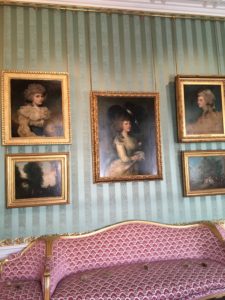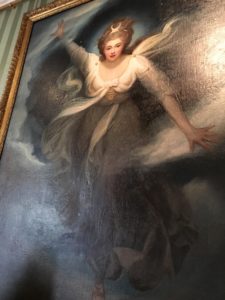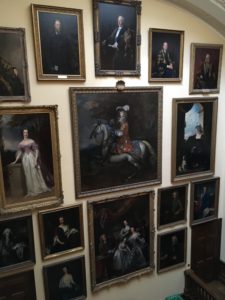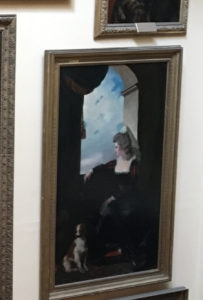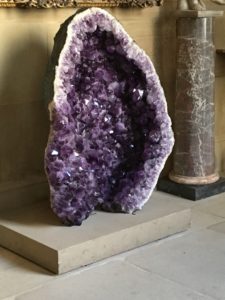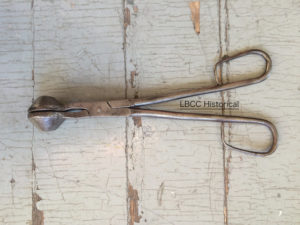My friend Kristine Hughes and I spent three days at Chatsworth on our May England trip and it was not enough time!
Chatsworth is the Derbyshire country house of the Duke of Devonshire, one of the first of the great country houses to be open to the public in order to raise enough money to save the place. The rescue of Chatsworth was the work of the late Duke and Duchess and what they achieved was a remarkable gift to their countrymen and the world.
Much of the success of Chatsworth must be given to the late Duchess of Devonshire, the former Deborah Mitford, youngest of the Mitford sisters, so captivating and/or scandalous that we are still talking of them today. Debo, as her sisters called her, had the imagination and drive to make Chatsworth the successful enterprise it is today, employing some 600 workers. In doing so she preserved a place of great beauty, both inside and out.
Here’s what we came upon that first day, after closing time, so there were no cars and very few people. It must have been close to what our Regency characters would have seen had they visited the house.
The beauty of the landscape was the work of Capability Brown, the famous landscape architect who popularized the naturalistic style in the mid-1700s. To enhance the beauty of the views from the front of Chatsworth House, Capability Brown required the 4th Duke of Devonshire to have the village of Edensor moved to a more picturesque location.
The next day we took the house tour and walked into the Painted Hall. The 4th Earl and 1st Duke of Devonshire was responsible for the Painted Hall. The artist was Louis Laguerre and the mural depicts the allegorical ascension of Julius Caesar. The upper walls show scenes from Caesar’s life. 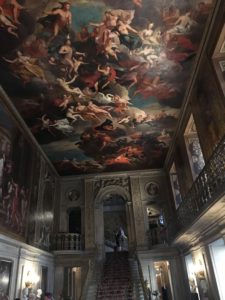
The 1st Duke had been one of the Immortal Seven who signed the invitation for William III of Orange to take the English throne, receiving the titles of Duke of Devonshire and Marquess of Hartington for his service. He rebuilt Chatsworth House and decorated it with symbolism celebrating King William’s monarchy. In the murals Julius Caesar sympbolizes William. Unfortunately William never saw the beautiful murals painted in his honor. He never visited Chatsworth.
In every hall and room there is something of interest to see. I took dozens of photos but didn’t cover a fraction of the beautiful art and furnishings of the house. In the music room there is a door ajar, revealing another door–and a violin.
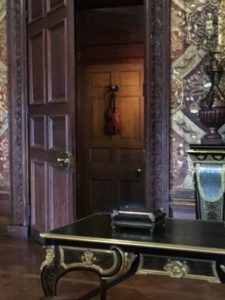
Look closely at the violin. Bet you can’t tell that it isn’t real. It is the painting of a violin, so realistic-looking that one must take it on faith because they don’t allow you to walk up to it and touch it.
Of course, there is homage to perhaps the most famous Duchess of Devonshire, Georgiana Cavendish. Georgiana, a celebrated beauty, married the Duke when she was a mere seventeen years old. She went on to be a successful political hostess, friend of the then Prince of Wales, campaigned for Charles James Fox. She was also a fashion icon. She was banished to the Continent for a while when she became pregnant by Charles Grey, but she filled her time there collecting minerals and gems. Her collection is on display in Chatsworth House.
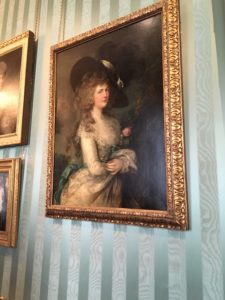
Not much was said on the tour of Georgiana’s friendship with Lady Elizabeth Foster, who became the Duke’s mistress and bore him two children raised a Chatsworth with Georgiana’s children and another of the Duke’s out-of-wedlock children. After Georgiana’s death in 1806, Lady Elizabeth Foster became the next Duchess of Devonshire.
The house tour ends at the sculpture gallery. Most of the works exhibited there were commissioned by Georgiana’s son, “Hart,” who became the 6th Duke of Devonshire and who was responsible for much of the art and improvements to the house and grounds.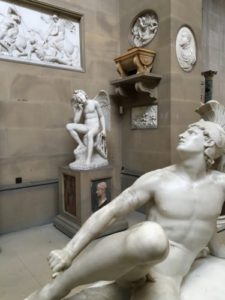
After our tour of the house, we visited the farm, which was more like a petting zoo for children, but Chatsworth is a working farm with its very successful farm shop, a place we, unfortunately, did not see.
The next day we took the garden tour and returned to the house again to walk through at our own speed. Here’s a snippet of what we saw on the garden tour.
There was so much more to see and more to see again. I would go back in a minute and do this all over again!
If you have a chance to visit Chatsworth, give yourself more than one day. You’ll be happy you did!
(My thanks to Denise Costello who helped me figure out how to appropriately size the videos to fit the blog!)


